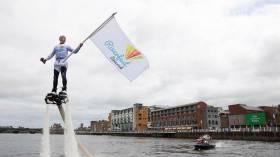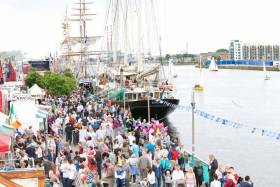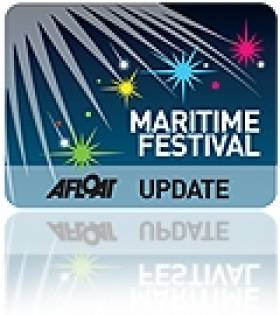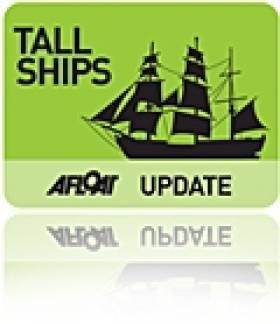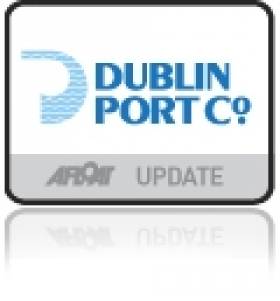Displaying items by tag: Riverfest
Just a day late for Dun Laoghaire harbour's 200th commemorations and 24 hours early for Dublin Port's Riverfest there is no doubting the evocative age of sail with the arrival of two tall ships sailing into Dublin Bay this morning.
The Earl Of Pembroke is moored in Scotsman's Bay, on the southside of Dublin Bay. The authentic square rigger is a replica of HMS Endeavour, the ship in whcih Captain Cook travelled to Australia in 1768. The modern Earl of Pembroke is 'for hire' for filming, charity and corporate events, as well as for personal charters and holidays. Read more on the Earl Of Pembroke here. The Earl of Pembroke is expected to sail from Dun Laoghaire up the River Liffey tomorrow at noon.
Read our Tall Ships Riverfest preview here
 Kaskelot, one of the last classic wooden Tall Ships, arrives in Dun Laoghaire Harbour
Kaskelot, one of the last classic wooden Tall Ships, arrives in Dun Laoghaire Harbour
The Kaskelot, a three-masted barque, is one of the largest remaining wooden ships in commission. She is moored in Dun Laoghaire Harbour today in advance of the weekend's Dublin Port's Riverfest that is previewed here. Read more on the Kaskelot here.
Although Riverfest is advertising eight tall ship arivals, there are only four visiting Dublin which could in any way be called a Tall Ship. After the arrival of the two this morning, it’s all eyes on the horizon for the Shtandard, the great Russian Tall Ship that will also visit Drogheda Port's Maritime Festival later this month.
Eight Tall Ships Open to the Public As Dublin Port Riverfest Set to Attract Over 100,000 Visitors
Dublin Port is preparing to help some 100,000 visitors discover their sea legs this June bank holiday weekend at Riverfest 2017, Ireland’s premier sailing and maritime festival. Now in its fifth year, the three-day maritime event will provide an €1 million boost to the local economy.
Taking place between the Samuel Beckett Bridge and the 3Arena from June 3rd -5th, Riverfest offers entertainment and activities for all the family, and admission is free.
Each year Riverfest, which is held by Dublin Port Company in association with Dublin City Council, brings a carnival atmosphere to North Wall Quay.
On the water, there will be plenty of thrills such as the UK ThunderCats power boats, which will be headlining the event with their first ever Dublin performance. ThunderCat Racing is one of the world’s most exhilarating water sports, with boats flying up to six metres in the air. The ThunderCats will be racing four times daily over the weekend.
Jet pack demonstrations and water sports such as stand up paddle boarding, sailing and kayaking are also among the highlights on the water.
For those who want to keep their feet on dry land there will be music, food markets, a funfair, zip lines, rock climbing and so much more. A new addition to Riverfest this year is the Drive-in cinema, which will use the world’s biggest mobile LED screen to show retro classics, Finding Nemo, Back to the Future and Jaws. Booking is essential.
Tall Ships Arrive
The festival’s favourite arrive in the city on Friday 2nd June. That afternoon the ships will berth along North Wall Quay and remain for the duration of the festival. Eight Tall Ships will be open to the public over the weekend to visit free of charge.
Eamonn O’Reilly, Chief Executive of Dublin Port Company, said: “I’m delighted to see Riverfest in its fifth year and growing from strength to strength. The festival promises something for absolutely everyone to enjoy. Set against the backdrop of the River Liffey, the Samuel Beckett Bridge and North Wall Quay, Riverfest is a uniquely Dublin experience. The sight of tall ships and schooners on the quayside reminds us of Dublin’s rich maritime heritage and modern day status as a port city. I would encourage everyone to come along and enjoy the spectacle and fun of Riverfest this year.”
Dublin City Council Chief Executive, Owen Keegan, said: “Riverfest is evolving as one of the marquee events of the city. The animation on and along the river over the bank holiday weekend is an exciting spectacle and festival for Dubliners and it further promotes Dublin to visitors as a city of culture and heritage.”
Limerick Riverfest Kicks Off Today For May Bank Holiday Weekend
#Festivals - Limerick becomes a mecca for watersport enthusiasts this May Bank Holiday weekend for the city’s Riverfest 2017, which kicks off today (Friday 28 April).
Highlights of the city’s premier summer maritime festival include the Riverfest BBQ Competition, the Riverfestival village in Arthur’s Quay Park, the Barringtons Hospital Great Limerick Run, a spectacular fireworks display.
At the centre of it all is the Maldron Hotel Riverfest on the Shannon, featuring wakeboarding with Irish champion David O Caoimh and pro jetboarders Scotty Knemeyer and Bo Krook, as well as the River Shannon Zipline between Arthur’s Quay and Honan’s Quay for more thrill-seeking visitors.
Exciting and skilful displays by Limerick Marine Search and Rescue, the Defence Forces, Foynes Yacht Club, Limerick’s numerous rowing clubs and yachting and sailability groups will mean all eyes will be firmly focused on the water.
For full details of the festival lineup visit the official website HERE.
And don’t forget the Dublin Port Riverfest that returns for the June Bank Holiday, as previously reported on Afloat.ie.
Dublin Port Riverfest Returns This June Bank Holiday
#Riverfest - North Wall Quay will once again play host to the Dublin Port Riverfest this June Bank Holiday weekend.
Tracing the River Liffey from the Ha’penny Bridge in the heart of Dublin City right out through Dublin Port and into Dublin Bay, the capital's maritime festival promises a variety of exciting activities and events.
On-the-water activities will include river ferries and cruises, boat tours of Dublin Port and Dublin Bay, special Try Sailing sessions on both sailing dinghies and keelboats, stand-up paddle boarding (SUP) sessions and kayaking trips.
The Jeanie Johnston will once again be offering free tours over the course of the weekend.
Customs officers will also be on hand all day with their cutter on view, and they will also be carrying out sniffer dog demonstrations.
The jam-packed schedule of displays and entertainment in the festival area includes jet pack displays, sailing races, dragon boat racing, powerboats, pilot displays, international tall ships and more.
Not to be outdone by the water, activities for landlubbers include zip Lines, rock climbing, music and street performances, carnival attractions, face painting and children’s art & circus workshops.
There will be pirate re-enactments all weekend, while Irish Village Markets will deliver an open-air food and craft market.
Dublin Riverfest returns this year from Saturday 3 to Monday 5 June from noon to 6pm daily. The events programme will be added shortly to the festival website HERE.
#Riverfest - The Dublin Bay Old Gaffers Association has timed its annual regatta to take place this weekend during the third Dublin Port Riverfest.
Weather permitting, the DBOGA will race in Dublin Bay for the Leinster Plate Trophy on Saturday 30 May, while on Sunday 31 May they will sail upriver to berth along the north quays and enjoy the festival's atmosphere before parading back to the Poolbeg Boat and Yacht Club.
Then on Bank Holiday Monday 1 June they will join an even bigger parade of sail to salute the departing tall ships – including the square rigger Kaskelot.
More details on the Old Gaffers' weekend plans – and how you can join in the fun – are available HERE.
And don't forget this summer's cruise in company along the 'Fastnet coast' in West Cork.
Taking place over the June bank holiday weekend (Saturday 30th May – Monday, 1st June 2015) along Dublin's historic North Wall Quay, Dublin's unique maritime festival has a pirate theme for 2015, featuring seafaring events and quayside activities to create a carnival celebration for all the family to enjoy. Now in its third year, the Dublin Port Riverfest is aiming to attract 65,000 visitors over the three days and expects to contribute a €1million boost to the local economy.
With plenty to attract both swashbucklers and landlubbers, highlight attractions include seven majestic tall ships and schooners open for the public to explore, flyboarder demonstrations, street performers such as juggler Jack Flash and music from unique Irish/Nigerian band Tig Linn.
#PortNews - The International Association of Port Cities (AIVP) will host its AGM for 2015 in Dublin next month ahead of the June Bank Holiday weekend.
'Working Waterfront' is the topic of the two-day meeting which begins with a general assembly at Dublin Castle on Thursday 28 May. Full details of the programme are available HERE.
"Few in number, and in high demand, waterfronts today are becoming strong identifying elements in port cities which are open to the world," according to the organisers, who identify such dynamic areas as 'city-port mixing in progress'.
Panels on the day will discuss city waterfronts as spaces geared towards the maritime economy, cultural activities and more.
They will be followed on Friday 29 May by a tour of Dublin's Docklands and Dublin Port to examine the Irish capital's particular challenges in regenerating its port and reintegrating it as part of the city.
And attendees will be free to enjoy the festivities of the Dublin Port Riverfest, which begins on Saturday 30 May running till Monday 1 June.
Now in its third year, visitors to North Wall Quay over the weekend should expect a "unique celebration" with "a jam packed programme of entertainment and family fun".
Not least among the events planned for the three-day celebration on the Liffey is the arrival of three tall ships and four schooners that will berth at North Wall Quay for the duration.
More details of the maritime festival programme will be available as the weekend draws near.
Coleraine Riverfest Is Ireland's Event Of The Summer
#Riverfest - Avid fans of watersports from across the UK & Ireland will descend on Coleraine on 9-10 August when the Waterways Ireland Riverfest takes place on the Lower Bann River and Christie Park.
On the water, wakeboarding, jetskiing and bare-footing demos will run throughout the day each day with competitive stand-up paddle boarding and sailing, rowing and angling all in the packed family fun programme.
Off the water, an inflatable fun area welcomes kids of all ages, alongside climbing walls, a boat and motor-home display, food and retail areas and the all-Ireland u90kg Strong Man and Strong Woman finals.
Sponsored by Waterways Ireland and supported by Coleraine Borough Council, the event runs 10.30am to 6pm on the Saturday and 12.30pm to 6pm on the Sunday and is free for all the family.
"The Waterways Ireland Riverfest in Coleraine receives our support because it engages more families, young people in waterway recreation in a spectacular and innovative fashion, leading the way with a range of events and activities you cannot experience elsewhere," said Waterways Ireland chief executive Dawn Livingstone.
"Thousands of people have enjoyed the Riverfest and have become great enthusiasts for their watersport and ambassadors for the event, the Lower Bann and Coleraine."
Rob Skelly, owner of The Edge Watersports in Coleraine and one of the event organisers, added: "The Waterways Ireland Riverfest has been a phenomenal success since we launched eight years ago. For 2014, the line-up will be bigger and better cementing its reputation as one of the best watersports events across the UK and Ireland.
"The natural waterway of the Lower River Bann provides a wonderful platform and backdrop for the magnificent displays. Once again we are delighted to be working alongside Waterways Ireland who is as ever supportive and actively promoting recreational opportunities on the inland waterways.
"Coleraine Borough Council are avid supporters of the event contributing since the events inception both financially and with some valued in-kind support, which has assisted the festival extend its land based offering to visitors on this idyllic site adjacent to the River Bann."
Mayor of Coleraine George Duddy met with the festival team by the River Bann to see for himself the wealth of entertainment planned for this year's event.
"Coleraine Borough Council has continued to support the development of this event as it attracts residents and visitors to an important location in the town," he said. "The River Bann provides the focus to this free family fun day, which is a great weekend for families of all ages, while supporting the local businesses to showcase the town for shoppers.
"I look forward to this year's event and congratulate all the teams involved in continuing to develop the Waterways Ireland Riverfest programme, as a significant attraction in the Borough's calendar of events."
For further information click on the Waterways Ireland Riverfest events page on Facebook HERE.
Unique Riverfest Liffey Race Gets Results for Howth 17s
A windless day played havoc for the Howth 17s fleet which battled to complete a course but they managed to complete two good races, the first race of their kind in Dublin writes Gillian Mills.
It is said that time and tide waits for no man, and neither can a working port whose lifting bridge determined when these classic craft and others in the Dublin Port Riverfest/OGA 50 had to exit to clear water.
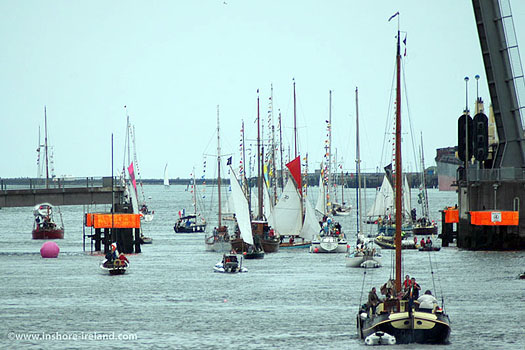
The full programme of activity includes:
Saturday 1st June
Tall Ships from 11am to 6pm
Tug Boat Displays 2pm
Markets 11am to 6pm
Children's Funfair from 11am to 6pm
MV Cill Airne Open Day from 11am to 6pm
DJ and Competitions from 11am to 6pm
Rowing & Curragh Races from 11am to 6pm
Madigans Bar and Cafe from 11am to 6pm
Facepainters and Balloon Artists from 11am to 6pm
Sunday 2nd June
Tall Ships from 11am to 4pm
Tug Boat Displays 2pm
Markets 11am to 6pm
Children's Funfair from 11am to 6pm
MV Cill Airne Open Day from 11am to 6pm
DJ and Competitions from 11am to 6pm
Madigans Bar and Cafe from 11am to 6pm
Facepainters and Balloon Artists from 11am to 6pm
'Between the Bridges' - Old Gaffers Howth 17′s Sailing Race 2pm-4pm
Parade of Sail (Over 50 Gaffers and Tall Ships) at 4pm
98FM Roadcaster Sunday 19th May from 11am to 6pm
Monday 3rd June
Tug Boat Displays 2pm
Markets 11am to 6pm
Children's Funfair from 11am to 6pm
DJ and Competitions from 11am to 6pm
MV Cill Airne Open Day from 11am to 6pm
Rowing & Curragh Races from 11am to 6pm
Madigans Bar and Cafe from 11am to 6pm
Facepainters and Balloon Artists from 11am to 6pm
Old Gaffers Barbecue Poolbeg Yacht Club 6pm-late
All activities will take place between the Samuel Beckett Bridge and East Link Bridge.





























